Hierarchical Clustering for Paired Watershed Experiments: Case Study in Southeastern Arizona, U.S.A.
Abstract
1. Introduction
2. Materials and Methods
2.1. Study Area
2.2. Spatial Database Development
2.3. Input/Output Correlations
2.4. Environmental Variable Analysis
2.5. Hierarchical Clustering Analysis
3. Results
3.1. Correlations between SWAT Input and Output Hydrologic Metrics
3.2. Variable Correlations and Selection
3.2.1. Structural Variables
3.2.2. Biophysical Variables
3.2.3. Hydrologic Metrics
3.2.4. Combined Variables
3.3. Variable Selection
3.4. Primary and Secondary Clusters
3.5. Geographically Paired Clusters
4. Discussion
4.1. Development of the Spatial Database
4.2. Structural Variables
5. Conclusions
Author Contributions
Funding
Institutional Review Board Statement
Informed Consent Statement
Data Availability Statement
Acknowledgments
Conflicts of Interest
References
- Clausen, J.C.; Jokela, W.E.; Potter, F.I.; Williams, J.W. Paired Watershed Comparison of Tillage Effects on Runoff, Sediment, and Pesticide Losses. J. Environ. Qual. 1996, 25, 1000–1007. [Google Scholar] [CrossRef]
- Clausen, J.C.; Spooner, J. Paired Watershed Study Design; Environmental Protection Agency Office of Wetlands, Oceans, and Watersheds. U.S.A.: Washington, DC, USA, 1993. [Google Scholar]
- Genereux, D.P.; Jordan, M.T.; Carbonell, D. A Paired-Watershed Budget Study to Quantify Interbasin Groundwater Flow in a Lowland Rain Forest, Costa Rica. Water Resour. Res. 2005, 41. [Google Scholar] [CrossRef]
- King, K.W.; Smiley, P.C.; Baker, B.J.; Fausey, N.R. Validation of Paired Watersheds for Assessing Conservation Practices in the Upper Big Walnut Creek Watershed, Ohio. J. Soil Water Conserv. 2008, 63, 380–395. [Google Scholar] [CrossRef]
- Veum, K.S.; Goyne, K.W.; Motavalli, P.P.; Udawatta, R.P. Runoff and Dissolved Organic Carbon Loss from a Paired-Watershed Study of Three Adjacent Agricultural Watersheds. Agric. Ecosyst. Environ. 2009, 130, 115–122. [Google Scholar] [CrossRef]
- Worqlul, A.W.; Ayana, E.K.; Yen, H.; Jeong, J.; MacAlister, C.; Taylor, R.; Gerik, T.J.; Steenhuis, T.S. Evaluating Hydrologic Responses to Soil Characteristics Using SWAT Model in a Paired-Watersheds in the Upper Blue Nile Basin. Catena 2018, 163, 332–341. [Google Scholar] [CrossRef]
- Ssegane, H.; Amatya, D.M.; Chescheir, G.M.; Skaggs, W.R.; Tollner, E.W.; Nettles, J.E. Consistency of Hydrologic Relationships of a Paired Watershed Approach. Am. J. Clim. Chang. 2013, 2, 147–164. [Google Scholar] [CrossRef][Green Version]
- Neary, D.G. Long-Term Forest Paired Catchment Studies: What Do They Tell Us That Landscape-Level Monitoring Does Not? Forests 2016, 7, 164. [Google Scholar] [CrossRef]
- Norman, L.M.; Brinkerhoff, F.; Gwilliam, E.; Guertin, D.P.; Callegary, J.; Goodrich, D.C.; Nagler, P.L.; Gray, F. Hydrologic Response of Streams Restored with Check Dams in the Chiricahua Mountains, Arizona. River Res. Appl. 2015, 32, 519–527. [Google Scholar] [CrossRef]
- Hewlett, J.D. Comments on the Catchment Experiment to Determine Vegetal Effects on Water Yield. J. Am. Water Resour. Assoc. 1971, 7, 376–381. [Google Scholar] [CrossRef]
- Hornbeck, J.W. The Problem of Extreme Events in Paired-Watershed Studies. Res. Note NE-175. Up. DarbyPA U.S. Dep. Agric. For. Serv. Northeast. For. Exp. Station. 1973, 175, 1–4. [Google Scholar]
- Wilm, H.G. How Long Should Experimental Watersheds Be Calibrated? Trans. Am. Geophys. Union 1949, 30, 272–278. [Google Scholar] [CrossRef]
- Zégre, N.P. Local and Downstream Effects of Contemporary Forest Harvesting on Streamflow and Sediment Yield. Ph.D. Thesis, Oregon State University, Corvallis, OR, USA, 2008. [Google Scholar]
- Bates, C.G. First Results in the Streamflow Experiment, Wagon Wheel Gap, Colorado. J. For. 1921, 19, 402–408. [Google Scholar]
- Bates, C.G.; Henry, A.J. Second Phase of Streamflow Experiment at Wagon Wheel Gap, Colo. Mon. Weather Rev. 1928, 56, 79–80. [Google Scholar] [CrossRef]
- Beschta, R.L.; Pyles, M.R.; Skaugset, A.E.; Surfleet, C.G. Peakflow Responses to Forest Practices in the Western Cascades of Oregon, USA. J. Hydrol. 2000, 233, 102–120. [Google Scholar] [CrossRef]
- Bosch, J.M.; Hewlett, J.D. A Review of Catchment Experiments to Determine the Effect of Vegetation Changes on Water Yield and Evapotranspiration. J. Hydrol. 1982, 55, 3–23. [Google Scholar] [CrossRef]
- Huang, M.; Zhang, L.; Gallichand, J. Runoff Responses to Afforestation in a Watershed of the Loess Plateau, China. Hydrol. Process. 2003, 17, 2599–2609. [Google Scholar] [CrossRef]
- Kincaid, D.R.; Osborn, H.B.; Gardner, J.L. Use of Unit-Source Watersheds for Hydrologic Investigations in the Semiarid Southwest. Water Resour. Res. 1966, 2, 381–392. [Google Scholar] [CrossRef]
- Ziemer, R.R.; Ryan, D.F. Current Status of Experimental Paired-Watershed Research in the USDA Forest Service. EOSTrans. Am. Geophys. Union 2000, 81, F380. [Google Scholar]
- Brandt, M.; Bergstroem, S.; Gardelin, M. Modelling the Effects of Clearcutting on Runoff-Examples from Central Sweden. Ambio Swed. 1988, 17, 307–313. [Google Scholar]
- Norman, L.M.; Niraula, R. Model Analysis of Check Dam Impacts on Long-Term Sediment and Water Budgets in Southeast Arizona, USA. Ecohydrol. Hydrobiol. 2016, 16, 125–137. [Google Scholar] [CrossRef]
- Zégre, N.P.; Skaugset, A.E.; Som, N.A.; McDonnell, J.J.; Ganio, L.M. In Lieu of the Paired Catchment Approach: Hydrologic Model Change Detection at the Catchment Scale. Water Resour. Res. 2010, 46, 1–20. [Google Scholar] [CrossRef]
- Yair, A.; Kossovsky, A. Climate and Surface Properties: Hydrological Response of Small Arid and Semi-Arid Watersheds. Geomorphology 2002, 42, 43–57. [Google Scholar] [CrossRef]
- Yetemen, O.; Istanbulluoglu, E.; Vivoni, E.R. The Implications of Geology, Soils, and Vegetation on Landscape Morphology: Inferences from Semi-Arid Basins with Complex Vegetation Patterns in Central New Mexico, USA. Geomorphology 2010, 116, 246–263. [Google Scholar] [CrossRef]
- Johnson, S.C. Hierarchical Clustering Schemes. Psychometrika 1967, 32, 241–254. [Google Scholar] [CrossRef] [PubMed]
- Rao, A.R.; Srinivas, V.V. Regionalization of Watersheds—An Approach Based on Clustering Analysis; Springer: Berlin/Heidelberg, Germany, 2008. [Google Scholar]
- Tasker, G.D. Comparing Methods of Hydrologic Regionalization. Water Resour. Bull. 1982, 18, 965–970. [Google Scholar] [CrossRef]
- Mosley, M.P. Delimitation of New Zealand Hydrlogic Regions. J. Hydrol. 1981, 49, 173–192. [Google Scholar] [CrossRef]
- Chiang, S.M.; Tsay, T.K.; Nix, S.J. Hydrologic Regionalization of Watersheds. I: Methodology Development. J. Water Resour. Plan. Manag. 2002, 128, 3–11. [Google Scholar] [CrossRef]
- Zhao, Y.; Karypis, G. Hierarchical Clustering Algorithms for Document Datasets. Data Min. Knowl. Discov. 2005, 10, 141–168. [Google Scholar] [CrossRef]
- Omernik, J.M. Ecoregions of the Conterminous United States. Ann. Assoc. Am. Geogr. 1987, 77, 118–125. [Google Scholar] [CrossRef]
- Adams, D.K.; Comrie, A.C. The North American Monsoon. Bull. Am. Meteorol. Soc. 1997, 78, 2197–2213. [Google Scholar] [CrossRef]
- Villarreal, M.L.; Haire, S.L.; Iniguez, J.M.; Cortés Montaño, C.; Poitras, T.B. Distant Neighbors: Recent Wildfire Patterns of the Madrean Sky Islands of Southwestern United States and Northwestern Mexico. Fire Ecol. 2019, 15, 2. [Google Scholar] [CrossRef]
- Arizona State Parks Patagonia Lake State Park Annual Weather. Available online: https://azstateparks.com/patagonia-lake/explore/weather (accessed on 2 October 2021).
- Arnold, J.G.; Moriasi, D.N.; Gassman, P.W.; Abbaspour, K.C.; White, M.J.; Srinivasan, R.; Santhi, C.; Harmel, R.D.; van Griensven, A.; Van Liew, M.W.; et al. SWAT: Model Use, Calibration, and Validation. Am. Soc. Agric. Biol. Eng. 2012, 55, 1491–1508. [Google Scholar] [CrossRef]
- Arnold, J.G.; Srinivasan, R.; Muttiah, R.S.; Williams, J.R. Large Area Hydrologic Modeling and Assessment Part I: Model Development. J. Am. Water Resour. Assoc. 1998, 34, 73–89. [Google Scholar] [CrossRef]
- Gassman, P.W.; Reyes, M.R.; Green, C.H.; Arnold, J.G. The Soil and Water Assessment Tool: Historical Development, Applications, and Future Research Directions. Trans. ASABE 2007, 50, 1211–1250. [Google Scholar] [CrossRef]
- SWAT Model. SWAT: Soil & Water Assessment Tool Model. 2018. Available online: https://swat.tamu.edu/ (accessed on 2 October 2021).
- NLCD. Multi-Resolution Land Characteristics (MRLC) Consortium National Land Cover Database. 2016. Available online: https://www.mrlc.gov/ (accessed on 2 October 2021).
- Villarreal, M.L.; Norman, L.M.; Wallace, C.S.A.; van Riper, C.I. A Multitemporal (1979–2009) Land-Use/Land-Cover Dataset of the Binational Santa Cruz Watershed. Open-File Report 2011–1131; U.S. Geological Survey: Reston, VA, USA, 2011. [Google Scholar]
- USDA. Web Soil Survey. 2019. Available online: http://websoilsurvey.nrcs.usda.gov/ (accessed on 2 October 2021).
- SWAT Output. SWAT Output Data: Primary Output Files. 2012. Available online: https://swat.tamu.edu/media/69395/ch32_output.pdf (accessed on 2 October 2021).
- Engelhardt, B.M.; Weisberg, P.J.; Chambers, J.C. Influences of Watershed Geomorphology on Extent and Composition of Riparian Vegetation. J. Veg. Sci. 2012, 23, 127–139. [Google Scholar] [CrossRef]
- Orellana, F.; Verma, P.; Loheide, S.P., II; Daly, E. Monitoring and Modeling Water-Vegetation Interactions in Groundwater-Dependent Ecosystems. Rev. Geophys. 2012, 50, 1–24. [Google Scholar] [CrossRef]
- Scott, R.L.; Cable, W.L.; Huxman, T.E.; Nagler, P.L.; Hernandez, M.; Goodrich, D.C. Multiyear Riparian Evapotranspiration and Groundwater Use for a Semiarid Watershed. J. Arid Environ. 2008, 72, 1232–1246. [Google Scholar] [CrossRef]
- SWAT Landuse. SWAT: Soil & Water Assessment Tool Landuse. 2018. Available online: https://oldgeni.isnew.info/landuse.html#_SWAT_landuse_classification (accessed on 2 October 2021).
- Wallace, C.S.A.; Villarreal, M.L.; Norman, L.M. Development of a High-Resolution Binational Vegetation Map of the Santa Cruz River Riparian Corridor and Surrounding Watershed, Southern Arizona and Northern Sonora, Mexico; Open-File Report 2011–1143; U.S. Geological Survey: Reston, VA, USA, 2011; pp. 1–22.
- Rawls, W.J.; Brakensiek, C.L.; Saxton, K.E. Estimation of Soil Water Properties. Trans. -Am. Soc. Agric. Eng. 1982, 25. [Google Scholar] [CrossRef]
- California Soil Resource Lab. Soil Data Explorer. 2011. Available online: https://casoilresource.lawr.ucdavis.edu/sde/ (accessed on 2 October 2021).
- Jones, K.B.; Edmonds, C.E.; Slonecker, E.T.; Wickham, J.D.; Neale, A.C.; Wade, T.G.; Riitters, K.H.; Kepner, W.G. Detecting Changes in Riparian Habitat Conditions Based on Patterns of Greenness Change: A Case Study from the Upper San Pedro River Basin, USA. Ecol. Indic. 2008, 8, 89–99. [Google Scholar] [CrossRef]
- Norman, L.M.; Villarreal, M.; Pulliam, H.R.; Minckley, R.; Gass, L.; Tolle, C.; Coe, M. Remote Sensing Analysis of Riparian Vegetation Response to Desert Marsh Restoration in the Mexican Highlands. Ecol. Eng. 2014, 70, 241–254. [Google Scholar] [CrossRef]
- Wilson, N.R.; Norman, L.M. Analysis of Vegetation Recovery Surrounding a Restored Wetland Using the Normalized Difference Infrared Index (NDII) and Normalized Difference Vegetation Index (NDVI). Int. J. Remote Sens. 2018, 39, 3243–3274. [Google Scholar] [CrossRef]
- Wilson, N.R.; Norman, L.M.; Villarreal, M.; Gass, L.; Tiller, R.; Salywon, A. Comparison of Remote Sensing Indices for Monitoring of Desert Cienegas. Arid Land Res. Manag. 2016, 30, 460–478. [Google Scholar] [CrossRef]
- Tucker, C.J. Red and Photographic Infrared Linear Combinations for Monitoring Vegetation. Remote Sens. Environ. 1979, 8, 127–150. [Google Scholar] [CrossRef]
- Gorelick, N.; Hancher, M.; Dixon, M.; Ilyushchenko, S.; Thau, D.; Moore, R. Google Earth Engine: Planetary-Scale Geospatial Analysis for Everyone. Remote Sens. Environ. 2017, 202, 18–27. [Google Scholar] [CrossRef]
- R Core Team. R: A Language and Environment for Statistical Computing; R Foundation for Statistical Computing: Vienna, Austria, 2020. [Google Scholar]
- Kassambara, A.; Mundt, F. R Package Factoextra. 2020. Available online: https://cran.r-project.org/web/packages/factoextra/index.html (accessed on 2 October 2021).
- Wickham, H.; Chang, W.; Henry, L.; Pedersen, T.L.; Takahashi, K.; Wilke, C.; Woo, K.; Yotani, H.; Dunnington, D. R Package ggplot2. 2020. Available online: https://cran.r-project.org/web/packages/ggplot2/ggplot2.pdf (accessed on 2 October 2021).
- Zambelli, A.E. A Data-Driven Approach to Estimating the Number of Clusters in Hierarchical Clustering. F1000Research 2016, 5, 1–14. [Google Scholar] [CrossRef] [PubMed]
- Rousseeuw, P.J. Silhouettes: A Graphical Aid to the Interpretation and Validation of Cluster Analysis. J. Comput. Appl. Math. 1987, 20, 53–65. [Google Scholar] [CrossRef]
- Banerjee, A.; Dave, R.N. Validating Clusters Using the Hopkins Statistic. IEEE Int. Conf. Fuzzy Syst. 2004. [Google Scholar] [CrossRef]
- Murtagh, F.; Contreras, P. Methods of Hierarchical Clustering Computer Science. Mathematics 2011, 1–21. Available online: https://arxiv.org/abs/1105.0121 (accessed on 2 October 2021).
- Petrakis, R.E.; Norman, L.M.; Vaughn, K.; Pritzlaff, R.; Weaver, C.; Audrey, R.H.; Ronald, P. Watershed Pairing of Sub-Basins within Smith Canyon Watershed Using a Hierarchical Clustering Approach: U.S. Geological Survey Data Release; U.S. Geological Survey: Reston, VA, USA, 2021. [CrossRef]
- Fleischner, T.L. Ecological Costs of Livestock Grazing in Western North America. JSTOR 1994, 8, 629–644. [Google Scholar] [CrossRef]
- Fesenmyer, K.A.; Dauwalter, D.C.; Evans, C.; Allai, T. Livestock Management, Beaver, and Climate Influences on Riparian Vegetation in a Semi- Arid Landscape. PLoS ONE 2018, 13, e0208928. [Google Scholar] [CrossRef]
- Gebremichael, M.; Vivoni, E.R.; Watts, C.J.; Rodriguez, J.C. Submesoscale Spatiotemporal Variability of North American Monsoon Rainfall over Complex Terrain. Am. Meteorol. Soc. 2007, 20, 1751–1773. [Google Scholar] [CrossRef][Green Version]
- Griffin, D.; Woodhouse, C.A.; Meko, D.M.; Stahle, D.W.; Faulstich, H.L.; Carrillo, C.; Touchan, R.; Castro, C.L.; Leavitt, S.W. North American Monsoon Precipitation Reconstructed from Tree-Ring Latewood. Geophys. Res. Lett. 2013, 40, 954–958. [Google Scholar] [CrossRef]
- Auerswald, M.; Moshagen, M. How to Determine the Number of Factors to Retain in Exploratory Factor Analysis: A Comparison of Extraction Methods under Realistic Conditions. Am. Psychol. Assoc. 2019, 24, 468–491. [Google Scholar] [CrossRef] [PubMed]
- Gorsuch, R.L. Exploratory Factor Analysis: Its Role in Item Analysis. J. Personal. Assess. 1997, 3891. [Google Scholar] [CrossRef]
- Yong, A.G.; Pearce, S. A Beginner’s Guide to Factor Analysis: Focusing on Exploratory Factor Analysis. Tutor. Quant. Methods Psychol. 2013, 9, 79–94. [Google Scholar] [CrossRef]


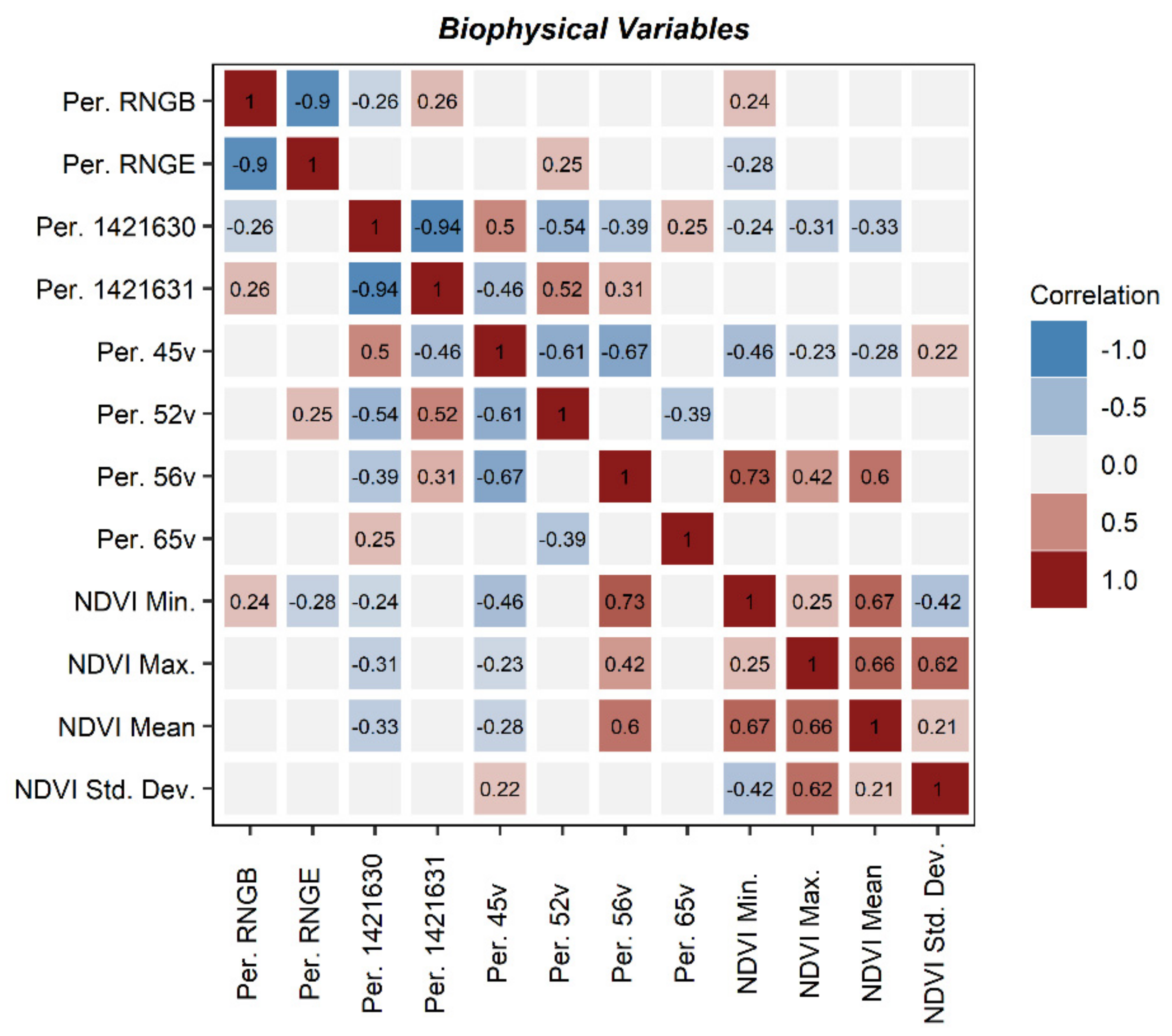
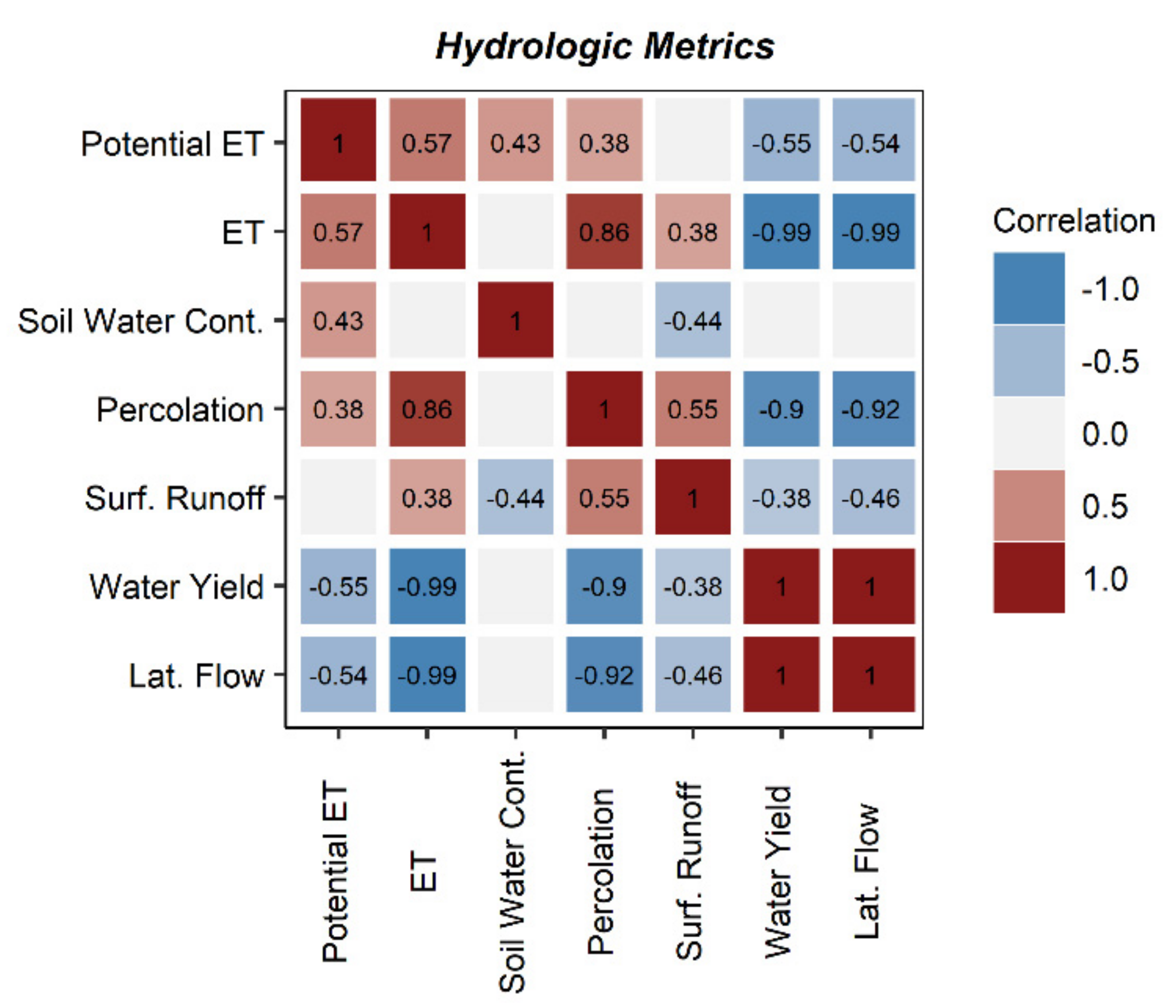

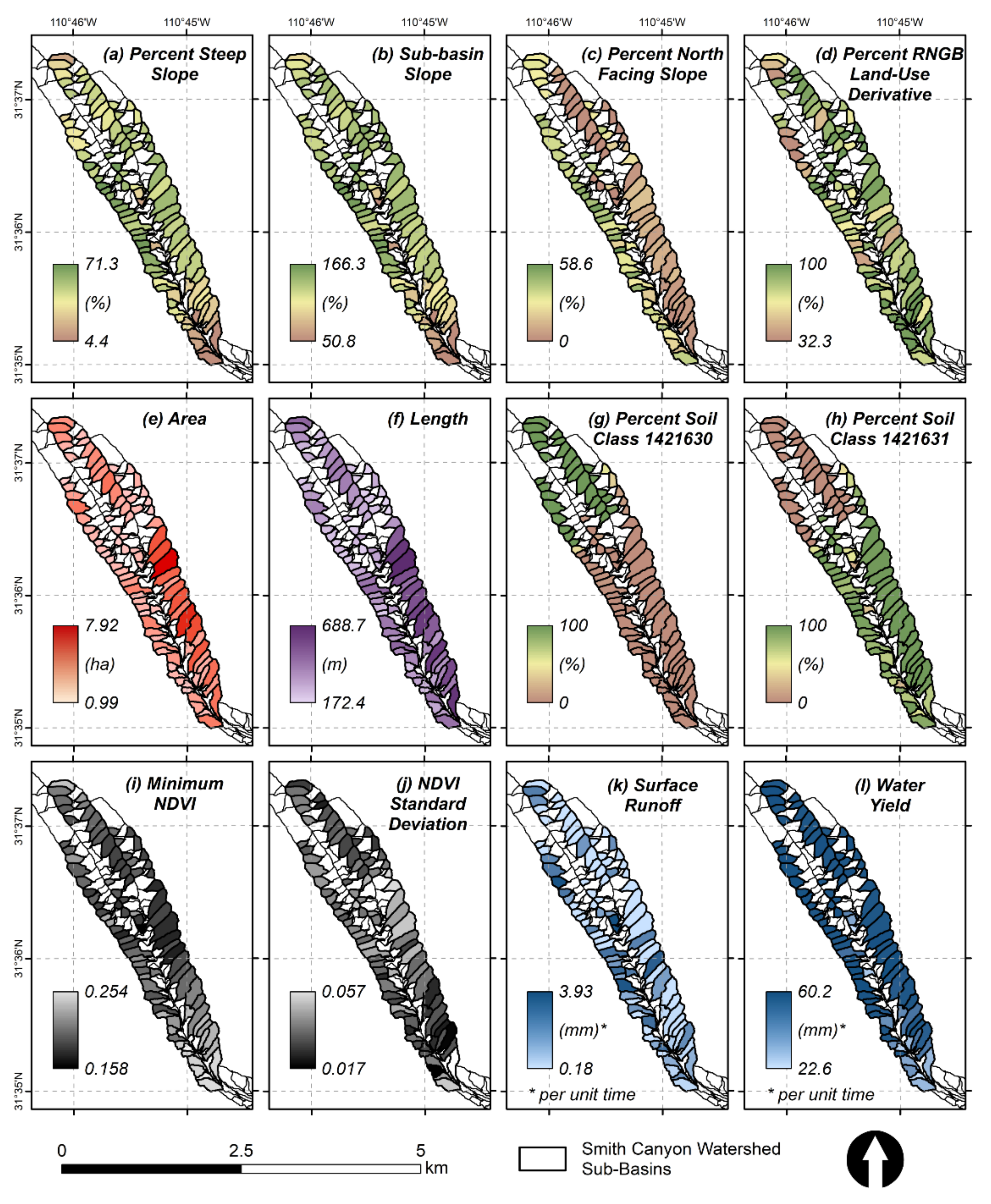
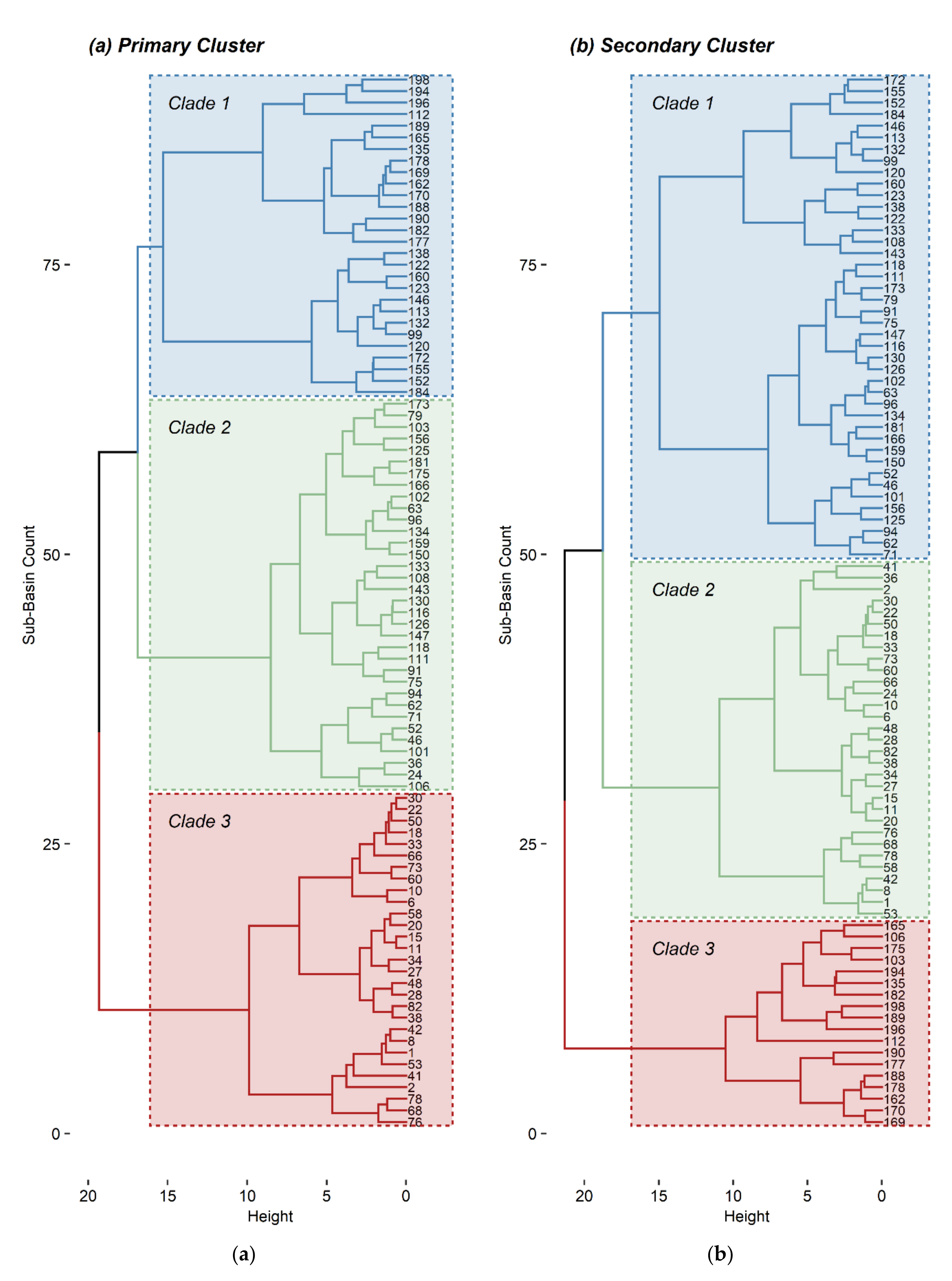
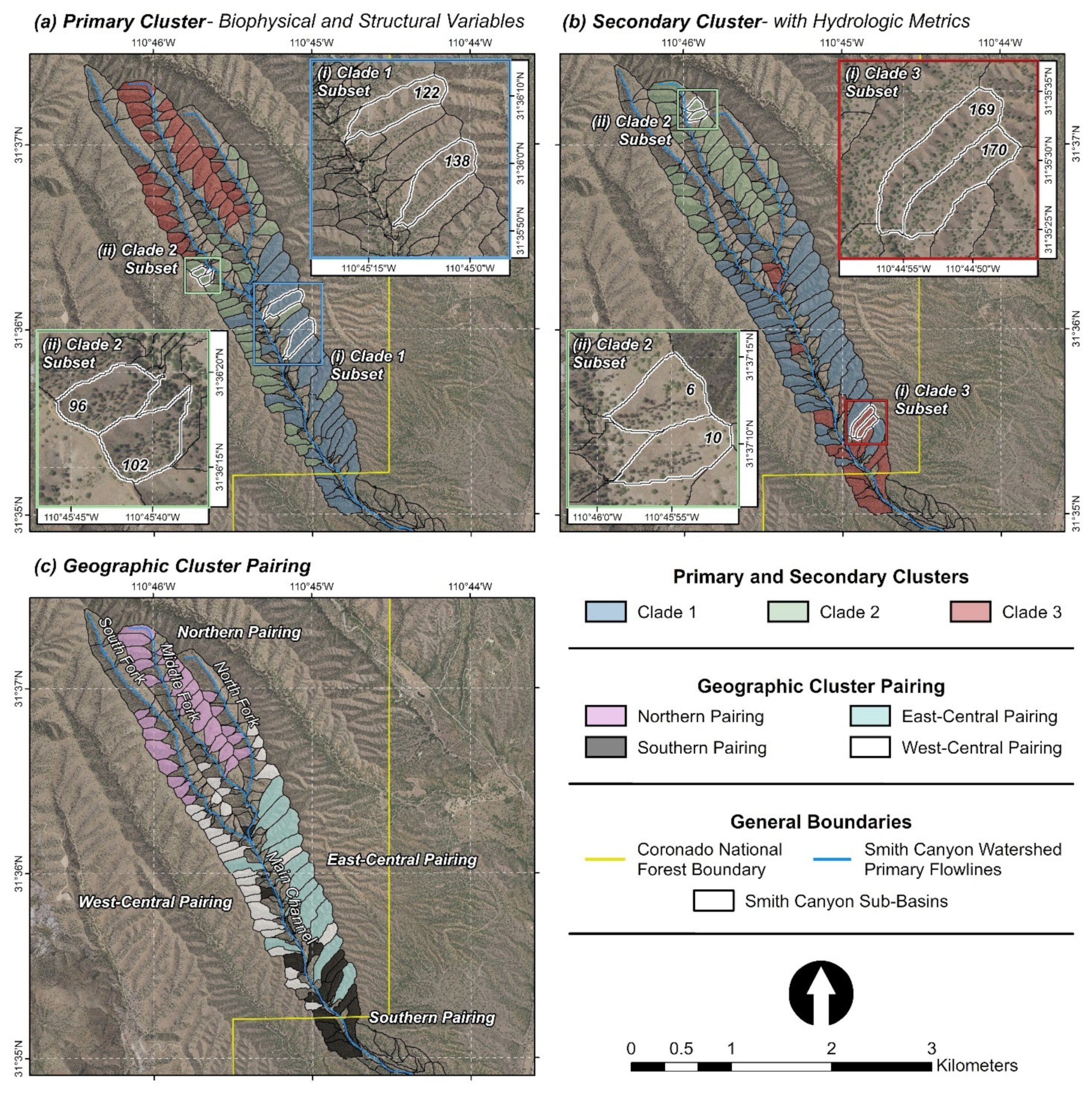
| Hydrologic Metric (Unit) | Short Name | Description |
|---|---|---|
| Potential Evapotranspiration (mm) | Potential ET | Potential evapotranspiration from the subbasin during the time step |
| Evapotranspiration (mm) | ET | Actual evapotranspiration from the subbasin during the time step |
| Soil Water Content (mm) | Soil Water Cont. | Amount of water in the soil profile at the end of the time step |
| Water Percolation (mm) | Percolation | Water that percolates past the root zone during the time step |
| Surface Runoff (mm) | Surf. Runoff | Surface runoff contribution to streamflow during the time step |
| Water Yield (mm) | Water Yield | Net amount of water that leaves the subbasin and contributes to streamflow in the reach during the time step |
| Lateral Flow (mm) | Lat. Flow | Average annual lateral flow in subbasin during the time step |
| (a) Structural Variables | |||
| Variable (Unit) | Short Name | Primary Source | Source Spatial Resolution |
| Mean Elevation (ft) | Mean Elevation | DEM | Sub-3 m |
| Minimum Elevation (ft) | Min. Elevation | DEM | Sub-3 m |
| Maximum Elevation (ft) | Max. Elevation | DEM | Sub-3 m |
| Percentage Low Slope (%) | Per. Low | SWAT derivative; DEM | Sub-3 m |
| Percentage Moderate Slope (%) | Per. Moderate | SWAT derivative; DEM | Sub-3 m |
| Percentage Steep Slope (%) | Per. Steep | SWAT derivative; DEM | Sub-3 m |
| Sub-basin Slope (%) | Sub. Slope | SWAT derivative; DEM | Sub-3 m |
| Width (m) | Width | SWAT derivative; DEM | Sub-3 m |
| Length (m) | Length | SWAT derivative; DEM | Sub-3 m |
| Area (ha) | Area | SWAT derivative; DEM | Sub-3 m |
| Perimeter (m) | Perimeter | SWAT derivative; DEM | Sub-3 m |
| Reach Length (m) | Reach Length | SWAT derivative; DEM | Sub-3 m |
| Percent North Facing Aspect (%) | Per. North | DEM | Sub-3 m |
| Percent East Facing Aspect (%) | Per. East | DEM | Sub-3 m |
| Percent South Facing Aspect (%) | Per. South | DEM | Sub-3 m |
| Percent West Facing Aspect (%) | Per. West | DEM | Sub-3 m |
| (b) Biophysical Variables | |||
| Variable (Unit) | Short Name | Primary Source | Source Spatial Resolution |
| Percent Range—Brush (%) | Per. RNGB | SWAT derivative; Villarreal et al. (2011) | 30 m |
| Percent Range—Grasses (%) | Per. RNGE | SWAT derivative; Villarreal et al. (2011) | 30 m |
| Percent Madrean Encinal—Class 45 (%) | Per. 45v | Wallace et al. (2011) | 30 m |
| Percent Apacherian-Chihuahuan Mesquite Upland Scrub—Class 52 (%) | Per. 52v | Wallace et al. (2011) | 30 m |
| Percent Chihuahuan Creosotebush, Mixed Desert and Thorn Scrub—Class 56 (%) | Per. 56v | Wallace et al. (2011) | 30 m |
| Percent Apacherian-Chihuahuan Piedmont Semi-Desert Grassland—Class 65 (%) | Per. 65v | Wallace et al. (2011) | 30 m |
| Percent Caralampi Gravelly Sandy Loam—10 to 40% Slopes (%) | Per. 1421630 | SWAT derivative; SSURGO | High-Resolution Vector |
| Percent Caralampi Gravelly Sandy Loam—0 to 60% Slopes, Eroded (%) | Per. 1421631 | SWAT derivative; SSURGO | High-Resolution Vector |
| Minimum NDVI | NDVI Min. | Mean NDVI Image; Landsat | 30 m |
| Maximum NDVI | NDVI Max. | Mean NDVI Image; Landsat | 30 m |
| Mean NDVI | NDVI Mean | Mean NDVI Image; Landsat | 30 m |
| NDVI Standard Deviation | NDVI Std. Dev. | Mean NDVI Image; Landsat | 30 m |
| (a) Structural Variables | ||||||
| Hydrologic Metric | Per. Low | Per. Moderate | Per. Steep | Min. Elevation | Max. Elevation | Mean Elevation |
| Potential ET | 0.69 * | −0.34 * | −0.41 * | −0.99 * | −0.99 * | −0.99 * |
| ET | 0.93 * | −0.15 | −0.76 * | −0.53 * | −0.59 * | −0.59 * |
| Soil Water Cont. | 0.24 * | −0.19 | −0.09 | −0.42 * | −0.44 * | −0.42 * |
| Percolation | 0.77 * | −0.24 * | −0.55 * | −0.34 * | −0.39 * | −0.40 * |
| Surf. Runoff | 0.34 * | −0.20 | −0.18 | −0.12 | −0.11 | −0.14 |
| Water Yield | −0.93 * | 0.16 | 0.75 * | 0.50 * | 0.57 * | 0.57 * |
| Lat. Flow | −0.92 * | 0.17 | 0.73 * | 0.49 * | 0.55 | 0.56 * |
| (b) Biophysical Variables | ||||||
| Hydrologic Metric | Per. RNGB | Per. RNGE | Per. 1421630 | Min. 1421631 | ||
| Potential ET | 0.23 * | −0.05 | −0.78 * | 0.67 * | ||
| ET | 0.12 | −0.08 | −0.35 * | 0.08 | ||
| Soil Water Cont. | 0.58 * | −0.41 * | −0.32 * | 0.42 * | ||
| Percolation | 0.04 | 0.03 | −0.28 * | −0.06 | ||
| Surf. Runoff | −0.70 * | 0.80 * | −0.11 | −0.08 | ||
| Water Yield | −0.14 | 0.10 | 0.34 * | −0.05 | ||
| Lat. Flow | −0.07 | 0.03 | 0.33 * | −0.04 | ||
| (a) Structural Variables | |||||
| Geographic Pairing | Per. Steep (%) | Sub. Slope (%) | Per. North (%) | Area (ha) | Length (m) |
| Northern | 46.8 | 141.9 | 22.2 | 2.3 | 294.1 |
| Southern | 21.1 | 90.9 | 14.1 | 2.3 | 371.5 |
| East-Central | 48.6 | 135.0 | 13.1 | 5.2 | 570.5 |
| West-Central | 58.8 | 150.4 | 33.6 | 1.7 | 283.2 |
| (b) Biophysical Variables | |||||
| Geographic Pairing | Per. RNGB (%) | Per. 1,421,630 (%) | Per. 1,421,631 (%) | NDVI Min. | NDVI Std. Dev. |
| Northern | 75.1 | 100.0 | 0.0 | 0.186 | 0.033 |
| Southern | 90.9 | 0.0 | 75.3 | 0.210 | 0.034 |
| East-Central | 77.5 | 0.2 | 96.1 | 0.182 | 0.036 |
| West-Central | 87.7 | 3.8 | 92.7 | 0.189 | 0.034 |
| (c) Hydrologic Variables | |||||
| Geographic Pairing | Surf. Runoff (mm) | Water Yield (mm) | |||
| Northern | 0.7 | 58.8 | |||
| Southern | 1.1 | 41.2 | |||
| East-Central | 0.9 | 57.2 | |||
| West-Central | 0.6 | 58.7 | |||
Publisher’s Note: MDPI stays neutral with regard to jurisdictional claims in published maps and institutional affiliations. |
© 2021 by the authors. Licensee MDPI, Basel, Switzerland. This article is an open access article distributed under the terms and conditions of the Creative Commons Attribution (CC BY) license (https://creativecommons.org/licenses/by/4.0/).
Share and Cite
Petrakis, R.E.; Norman, L.M.; Vaughn, K.; Pritzlaff, R.; Weaver, C.; Rader, A.; Pulliam, H.R. Hierarchical Clustering for Paired Watershed Experiments: Case Study in Southeastern Arizona, U.S.A. Water 2021, 13, 2955. https://doi.org/10.3390/w13212955
Petrakis RE, Norman LM, Vaughn K, Pritzlaff R, Weaver C, Rader A, Pulliam HR. Hierarchical Clustering for Paired Watershed Experiments: Case Study in Southeastern Arizona, U.S.A. Water. 2021; 13(21):2955. https://doi.org/10.3390/w13212955
Chicago/Turabian StylePetrakis, Roy E., Laura M. Norman, Kurt Vaughn, Richard Pritzlaff, Caleb Weaver, Audrey Rader, and H. Ronald Pulliam. 2021. "Hierarchical Clustering for Paired Watershed Experiments: Case Study in Southeastern Arizona, U.S.A." Water 13, no. 21: 2955. https://doi.org/10.3390/w13212955
APA StylePetrakis, R. E., Norman, L. M., Vaughn, K., Pritzlaff, R., Weaver, C., Rader, A., & Pulliam, H. R. (2021). Hierarchical Clustering for Paired Watershed Experiments: Case Study in Southeastern Arizona, U.S.A. Water, 13(21), 2955. https://doi.org/10.3390/w13212955






